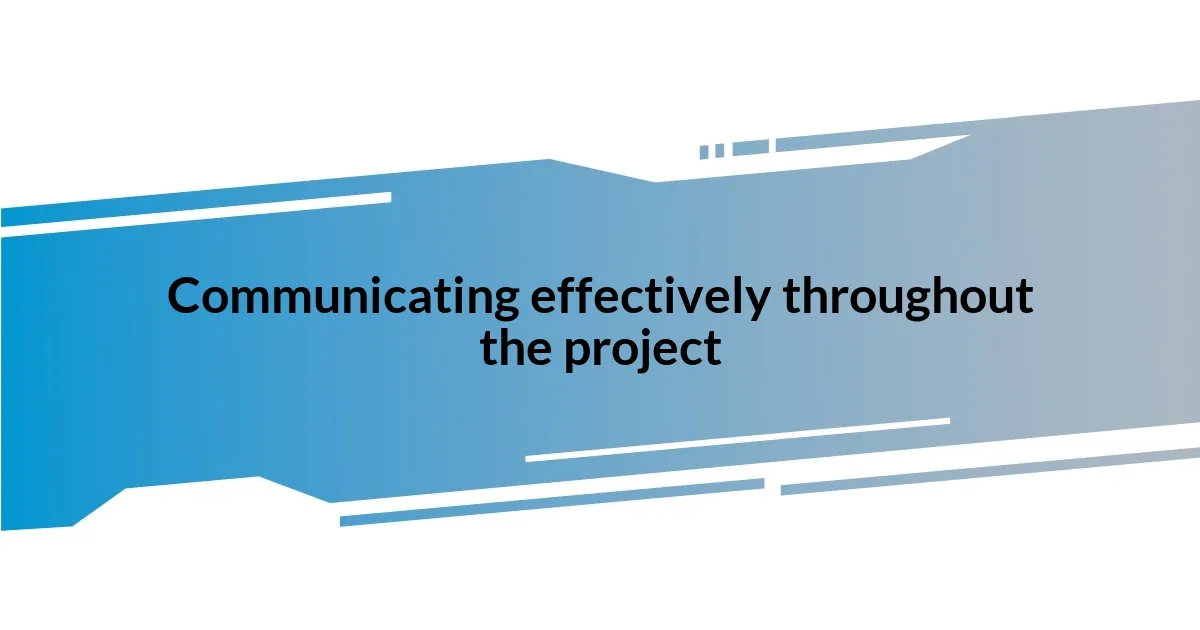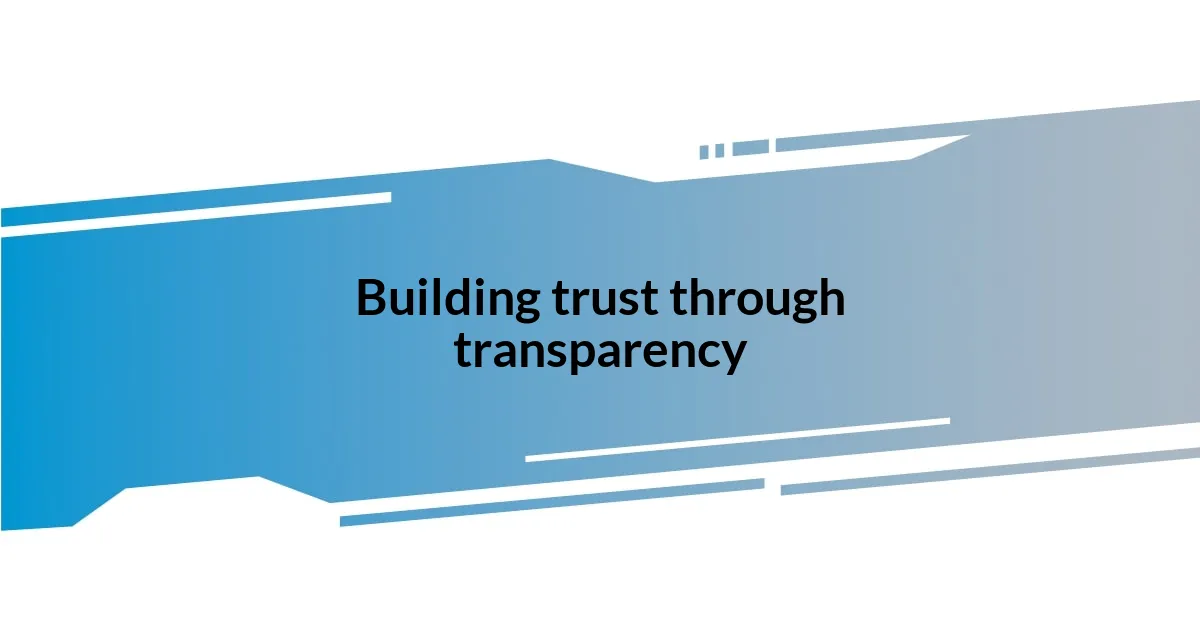Key takeaways:
- Understanding client needs through active listening and empathy leads to stronger partnerships.
- Setting realistic timelines with buffer periods prevents stress and enhances trust.
- Proactive communication and transparency, especially during challenges, foster collaboration and client satisfaction.
- Gathering feedback and showing appreciation creates opportunities for improvement and strengthens client relationships.

Understanding client needs clearly
One of the most enlightening moments I’ve had in my career was during a kickoff meeting where I uncovered a client’s real motivations. Instead of assuming they just wanted a sleek website, I asked about their goals. Through that simple question, I learned they were driven by the desire to attract more local customers. Knowing this shifted my entire approach to the project, aligning our efforts with their ultimate vision.
I often find that clients have unspoken needs lurking beneath the surface. For example, a client once said they wanted a specific feature, but it later became clear that their main priority was usability for seniors. This revelation not only changed the project scope but also deepened my connection with the client. Isn’t it fascinating how asking the right questions can transform the dialog into a real partnership?
Understanding client needs isn’t just about gathering requirements; it’s about empathy and active listening. I remember a late-night brainstorming session where I encouraged a client to share their concerns openly. That space for vulnerability not only clarified their needs but also built trust, showing that I’m truly invested in their project. Have you ever experienced a moment where a simple conversation changed everything? I certainly cherish those encounters.

Setting realistic project timelines
Setting realistic project timelines is essential for maintaining trust and ensuring satisfaction. I’ve seen countless instances where an overly ambitious timeline led to stress and disappointment. In one memorable project, we initially estimated a three-month completion time. However, after assessing the complexities involved, I communicated with the client to extend it to five months. This simple adjustment meant less frantic pressure on the team and allowed us to deliver a top-notch product.
When discussing timelines, I always emphasize the importance of buffer periods. I learned this the hard way when a project ran over schedule due to unexpected technical challenges. By adding a week or two as a cushion, I could manage my client’s expectations more effectively, giving us the flexibility to tweak designs or fix bugs without the fear of missing deadlines. It’s about setting clients up for success rather than just hitting the finish line.
Another valuable approach is fostering open dialogue about project stages. I remember when I implemented regular check-ins with the client throughout a website overhaul. By breaking the project into phases, we celebrated small victories, which built excitement and a sense of shared accomplishment. Clients appreciated the transparency and felt involved, making them more understanding of any adjustements to the timeline down the road. It’s a win-win that ultimately cultivates stronger relationships.
| Timeline Approach | Benefits |
|---|---|
| Ambitious timelines | Risk of disappointment, stress |
| Realistic timelines | Builds trust, manages expectations |
| Including buffer periods | Provides flexibility for adjustments |
| Regular check-ins | Enhances client involvement, transparency |

Communicating effectively throughout the project
Effective communication throughout a project is, in my experience, the backbone of client relationships. I remember a scenario where we faced an unexpected technical hiccup in the middle of a project. Instead of waiting until the next scheduled update, I reached out to the client immediately. I explained the issue candidly, shared our action plan, and reassured them that we were committed to a resolution. Their appreciation for the transparency reinforced my belief that proactive communication fosters trust and strengthens collaboration.
Another practice I’ve found invaluable is crafting a communication plan at the project’s outset. This plan sets expectations on how often we’ll communicate and through which channels. I often create a simple guideline that includes:
- Communication methods: Email for quick updates, video calls for detailed discussions.
- Update frequency: Weekly status emails, bi-weekly calls, and ad-hoc check-ins as needed.
- Feedback loops: Establishing specific moments for client feedback to keep them engaged.
This structure not only showcases my organization but also makes clients feel like they are part of the journey every step of the way. It’s amazing how clarity in communication can transform a project experience into a collaborative adventure!

Managing scope changes efficiently
When it comes to managing scope changes, I’ve learned that transparency is key. On one project, we had a last-minute request for additional features that, honestly, could have derailed our timeline. By quickly gathering my team to assess the impact of these changes, I was able to present the client with clear options: we could either add the features with a new deadline or prioritize them for a future phase. This not only helped navigate the change smoothly, but it also kept the client engaged in decision-making, which they appreciated.
I’ve also found that maintaining a flexible mindset can be a game-changer. During a recent project, a client decided to pivot the entire direction halfway through. Instead of seeing this as a setback, I embraced it as an opportunity to enhance the project’s relevance to their needs. We set up a brainstorming session, which not only energized the team but also made the client feel like a vital part of the project’s evolution. Have you ever experienced a shift like that? It’s often in those moments of uncertainty that the best ideas emerge.
Establishing a clear change management process is something I can’t recommend enough. Whenever a scope change arises, I create a simple but effective change request template that outlines what’s changing, why it matters, and the potential impact on timelines and budget. I remember presenting this template to a client who was initially skeptical about additional costs due to feature creep. After using the template to provide clarity, they understood the value of their requests and made informed decisions. This practice not only streamlined our workflow, but it also fostered a sense of shared responsibility, which made collaboration feel more seamless.

Maintaining regular progress updates
When I implement regular progress updates, I often sense a shift in my clients’ attitudes. For instance, I remember one project where I opted for daily updates instead of the usual weekly check-ins. Knowing they were anxious about the timeline, these frequent touchpoints not only eased their worries but also built an incredible level of trust. I could tell how much it meant to them to know they were always in the loop.
One of my go-to strategies is to showcase not just progress but also the challenges we encounter along the way. I’ll share a recent experience: we faced some unexpected delays due to integration issues. Rather than glossing over it, I candidly addressed the situation in my updates. I explained the hurdles while outlining our action plan to overcome them. The transparency was eye-opening for the client; they appreciated my honesty and even offered helpful insights based on their own experience in the industry. Isn’t it remarkable how challenges can actually strengthen the bond between you and your client?
To make progress updates engaging, I often incorporate visual elements. I’ll use simple dashboards or charts to highlight milestones and milestones achieved. One time, I created a visual timeline for a client showcasing where we were versus where we aimed to be. The excitement I observed when they saw their project moving forward, even with a few bumps along the way, was absolutely rewarding. It reinforced that keeping the client visually informed not only maintains their interest but also turns every update into a shared celebration of progress.

Building trust through transparency
When I prioritize transparency in client interactions, I often notice a palpable shift in our working relationship. For example, during a challenging project, I made it a point to share not only our successes but the tough moments too. One afternoon, after a particularly grueling day dealing with technical issues, I sent my client a note explaining the setbacks. Their response? “Thanks for being open about it.” This kind of honesty paved the way for deeper trust; it made me realize how vulnerability can actually strengthen relationships.
I’ve found that being transparent about potential risks can also foster a mature dialogue. In one instance, a client wanted to pursue a very ambitious timeline for their website launch. Rather than just nodding and agreeing, I brought them into a candid conversation about the risks involved. Together, we explored what could go wrong and strategized contingency plans. This process not only reassured them that I was on their side but also built a stronger collaborative spirit. Isn’t it refreshing to work with clients who feel empowered to take part in such important decisions?
Moreover, I’ve discovered that sharing my own lessons learned along the way positively impacts transparency. One project didn’t go entirely as planned, and I openly shared what I would’ve done differently. I remember the client’s reaction—they were grateful for the insight and said it made them more confident in my expertise. This level of openness creates a richer dialogue where clients feel they’re not just observers but active participants in the project’s journey. What would it mean for you if your clients felt consistently informed and involved in the process? I believe it could transform ordinary projects into meaningful partnerships.

Gathering feedback for future improvements
Gathering feedback is a crucial step for refining future projects, and I’ve found that it often leads to unexpected insights. Recently, after completing a web project, I sent out a simple survey asking for client thoughts on various aspects of our collaboration. To my surprise, they highlighted not only what I expected but also a few minor details I hadn’t considered. This reminded me how valuable it is to open the floor for dialogue. How can we make informed improvements if we don’t fully understand our clients’ perspectives?
I’ve discovered that informal conversations can yield rich feedback, too. During a casual coffee meeting with a client after completing a project, we reflected on what worked well and what didn’t. They shared their appreciation for our brainstorming sessions but mentioned feeling a bit overwhelmed by the rapid pace at times. This candid exchange helped me realize that while pushing for efficiency is essential, I must also tailor my approach to comfortably align with each client’s working style. Have you ever thought about how a simple chat could uncover areas for growth?
Moreover, I always make it a point to express gratitude when clients share their feedback. After receiving specific suggestions for future enhancements on a project, I acknowledged their thoughts in our follow-up emails. Their gratitude for being heard created a sense of partnership, inspiring them to share even more insights. It’s fascinating how a culture of feedback can lead to deeper connections and pave the way for smoother future projects. Isn’t it wonderful when our clients feel empowered to contribute their voices?